Careel Creek
Geological History
The familiar coastal
landscapes of the Northern Beaches have developed quite recently in geological
time. The earlier coastline during the last glaciation was about 20 kilometres
to the east. Today’s familiar beaches and estuaries developed as a result of
sea level rise as the ice age ended, about 10 000 years ago. The sea reached
its present level about 6000 years ago.
Many beaches along the NSW coast are
(or were) backed by dunes with a wetland, lagoon or creek behind the dunes, into
which the hinterland drains. Typically the lagoon opens periodically to the
ocean. The opening generally is where dunes are lowest, at the north end of the
ocean beach. Southerly ocean currents and winds carry sand northwards until
blocked by a rocky headland. Narrabeen Lagoon and beach is a typical example.
ICOLL is the acronym geologists give to this landscape feature – intermittently
closed and open lake or lagoon.
Avalon Beach and Careel Creek, before European settlement, would have been a similar landscape formation. However, the catchment of Careel Creek is much smaller than that of many along the coast, bounded by the ridges of Avalon Golf Course, Bilgola Plateau, the rise towards Clareville, Stapleton Park and the slopes near Kevin Ave and George St. The creek behind the dunes was quite wide and shallow and would have retained water much like a coastal lagoon particularly after heavy rainfall events. But perhaps there never was enough water flowing down the creek to force its way through dunes. Also, the lie of the land is lower towards Pittwater so the creek flows into the receiving waters of Careel Bay.
Careel Creek since European settlement
The name Careel is thought to be a corruption of the word Careen – the hauling ashore of boats for maintenance and to clean the hull of marine life. The earliest recorded European settlement at Careel Bay occurred in 1818 with the area developing as farm land. Europeans came to the area not just to farm but as fishermen, vegetable gardeners, shell diggers, small boat builders and coastal traders. More about Careel Bay: (Careel Bay Org History)
In the early days of settlement, about 1840-1880, the Collins family had a dairy farm at Careel Bay. It occupied most of North Avalon. They leased the land from Father Therry. The creek was dammed just south of the present North Avalon Rd to ensure a supply of freshwater. It had an earth wall, with a spillway on the western side. Below the dam Barrenjoey Rd crossed the creek. A 1930 aerial photo indicates the dam was well and truly gone but had left a strange “kink” in the creek.
In the 1940s Bill McDonald, a prominent citizen of early Avalon, was able to paddle his surf ski up to the shops, when the tide was high and especially after a heavy downpour. This would have been before the creek behind the dunes was turned into an open concrete drain.
Careel Creek – or Avalon Main Drain?
The
catchment of the creek has been progressively urbanised. With settlement come
increased and sudden flows of stormwater off the hard surfaces of roads and
roofs. Avalon shopping centre is almost at sea level. Flooding has been a
problem, particularly when heavy rain coincides with high tides.
One early
solution to this was to turn the upper section of Careel Creek into a concreted
open drain, in the hope of speeding the flow of stormwater which would have been
impeded by the wetland and vegetation downstream. Pittwater Council staff
believe the concrete drain was installed when Barrenjoey Rd was widened in the
1960s.
To reduce risk of flooding, more recently (2005)a stormwater detention basin was installed in the grassed area beside Old Barrenjoey Rd and the drain under North Avalon Rd widened (2008). For more information about flooding: (Pittwater Council Flooding Doc.)
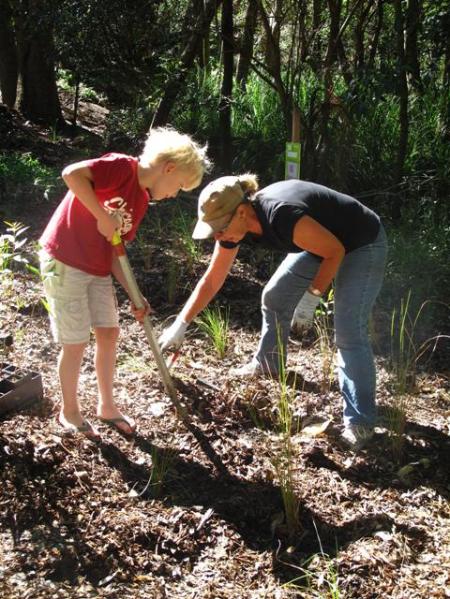
Above: Planting near the creek at Etival St.
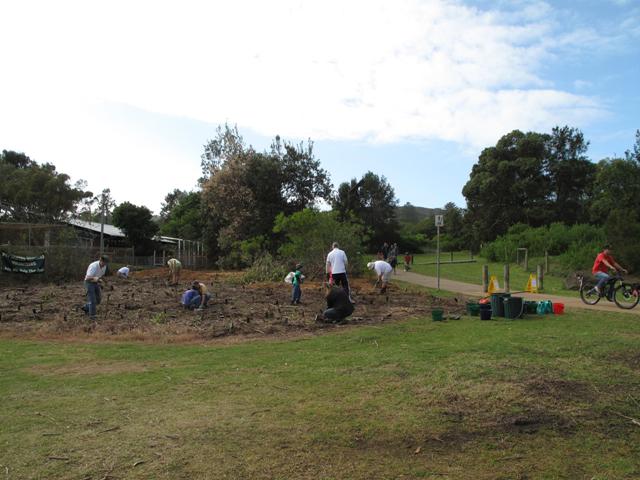
Above: Bushcare volunteers planting tubestock in November 2011
Water Quality
Another effect of urban
development has been a deterioration in water quality in the creek. Wetlands are
natural filters for organic and mineral sediments and plant nutrients such as
phosphorus. The concrete drain allows any pollutants in the catchment wash
straight down the creek. A Gross Pollutant Trap near the eastern end of Central
Rd catches large items such as plastic bottles and other rubbish, also larger
organic material such as leaves. However water quality is not suitable for
swimming.
The concrete drain ends near alongside the Barrenjoey High
School fence. Then the creek’s banks and bed are of mud and sand. Occasionally
the creek’s lower reach gives off strong unpleasant sulphurous smells. Pittwater
Council undertook investigations into the odours from the creekline and has
determined that the source of the smell is natural anaerobic decomposition of
leaf litter and other organic matter washed down the creekline. For more
information:
(Pittwater Council Careel Creek Plan of Mangement)
Dredging to reduce flooding and smells is not an option because of the presence of acid sulfate soils. Like sleeping dogs, these must be let lie. Acid Sulfate Soils occur naturally in both coastal (tidal) and inland or upland (freshwater) settings. Left undisturbed, these soils are harmless, but when excavated or drained, the sulfides within the soil react with the oxygen in the air, forming sulfuric acid. This acid, together with associated toxic elements (heavy metals and other contaminants), can kill plants and animals, contaminate drinking water and food such as oysters, and corrode concrete and steel. This would be a disaster for Careel Bay.
Careel Creek, Avalon Dunes & Careel
Bay
These areas offer valuable habitat to wildlife, all the more so
if they are connected. Avalon Dunes was once infested with Bitou Bush, the
creek’s banks with various woody weeds and Careel Bay’s saltmarsh areas were
under attack from Asparagus Fern and other weeds.
Since 1990 ongoing bush regeneration projects have enabled local native vegetation to replace the weeds and recreate valuable fauna habitat. To provide this link to Careel Bay, Careel Creek’s banks are being progressively revegetated with local native plants.
Current revegetation work (2012) along the section from the sewer pumping station to North Avalon Rd is being funded by a Community Action grant to Pittwater Natural Heritage Association, in partnership with Pittwater Council. The grant is from the Federal Government via Hawkesbury Nepean Catchment Authority. Students from Barrenjoey High School, Avalon Public School and community volunteers have helped with planting tubestock here.
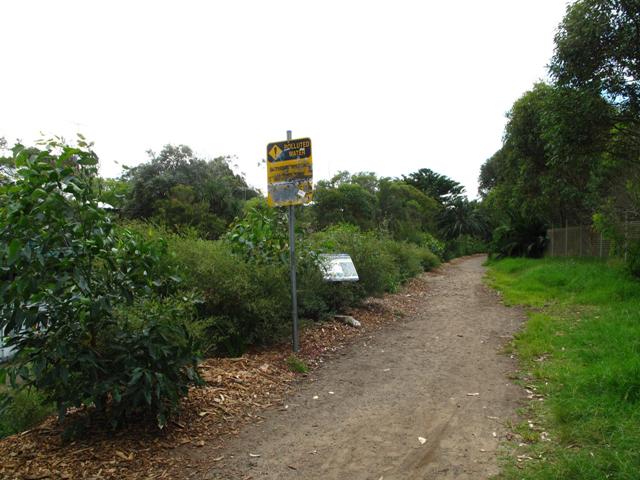
Trees & shrubs are growing fast. Swamp Mahogany (Eucalyptus robusta) will provide winter food for honeyeaters and lorikeets.
Fauna
Birds often seen along the creek
include: Pacific Black Ducks, Australian White Ibis, Little Pied Cormorant,
White-faced Heron. Unfortunately many of the ducklings are eaten by large eels.
As native plants grow small birds such as Superb Wren, Spotted Pardalote and
White-browed Scrub Wren will forage for insects there. Watch for the mud nests
of Magpie Larks in the trees on the western bank.
The Bush Stone-curlew is an endangered species in the Sydney area, but breeds in Careel Bay. During 2011 one was often seen along the creek or nearby. This bird needs open woodland or saltmarsh, with fallen branches to hide among, as it relies on camouflage to protect itself and its nest on the ground.
Schools of small fish, perhaps mullet, come upstream to the start of the concrete. The highest tides push upstream to about this point. So despite the poor water quality from a human perspective, at least some fauna find it acceptable.
The walking track from Avalon to North Avalon, the “Yellow Brick
Road”, swings eastwards around the dunes before the sewer pumping station. But
an informal track continues along the east bank of the creek. By a quirk of past
subdivision, the rear boundaries of some Elaine Ave properties adjoin the
western high school boundary in midstream. So this track is actually on school
property.
Unfortunately much of the western creek bank here is private
property and very weedy. We can but hope for future improvements.
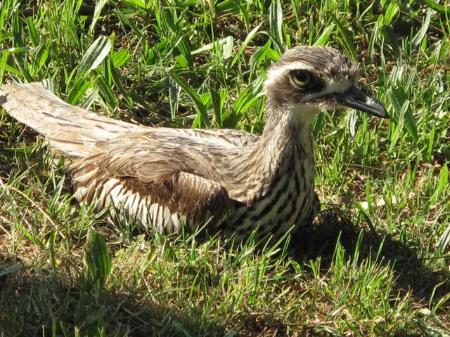
Above: Stone Curlew, October 2011.
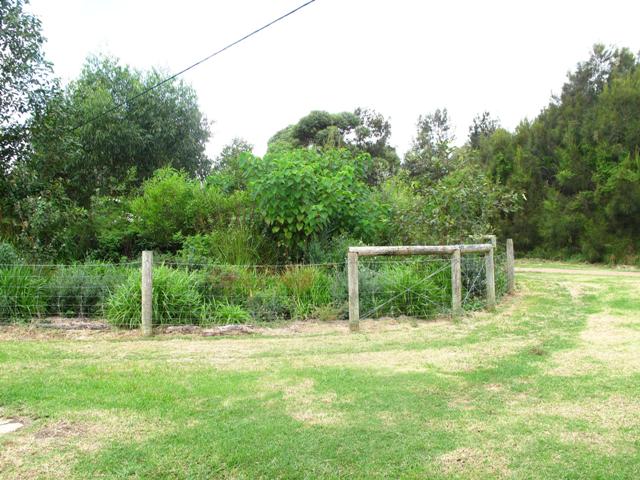
Trees planted near sewer pumping station, March 2012
More Information:
Map of Careel Creek Catchment: at Pittwater Council
Acid sulphate soils:
http://www.clw.csiro.au/acidsulfatesoils/
Compiled by Marita Macrae, Geoff Searl and Paul Hardie.
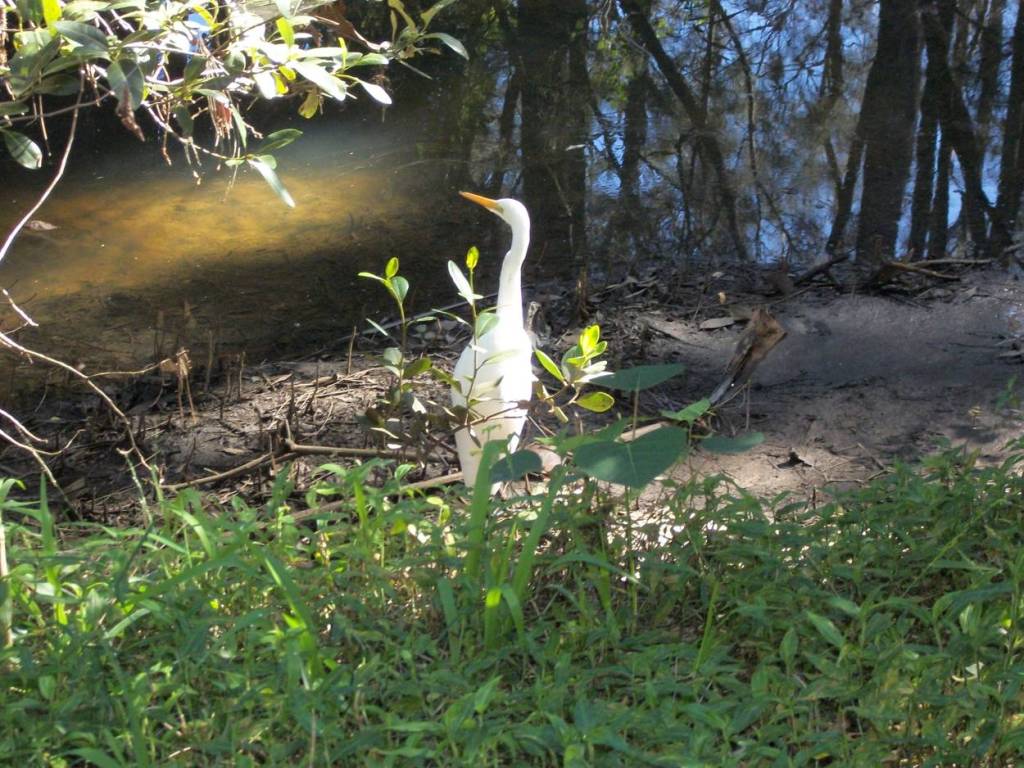
Eastern Great Egret Ardea alba modesta; a white heron, on Careel Creek, January 2012
The name "Careel" may also be related to the word "Creel", which refers to a large wicker basket for fish or an angler's fishing basket. (Ref Oxford Dictionary). The addition of the letter "a" would most likely have been because of a pronunciation difference in the early days of Pittwater, when there were many fishermen in the bay. : Shelagh and George Champion